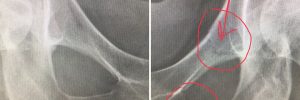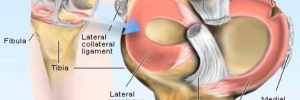Yes, but not often, only less than 5% of the time. Why? The meniscus is divided up into three zones. Two of the three zones have a very poor blood supply. Blood is needed to aid in a repair. Sutures can be placed to hold the torn meniscus together, but if there is no blood supply… Read more »
Monthly Archives: March 2019
Does Removing a Torn Meniscus Harm the Knee Joint?

The meniscus is a shock absorber in the knee. The part of the meniscus that tears no longer has shock absorber properties. The torn part of the meniscus causes pain, irritation to the knee and on occasion mechanical symptoms such as catching and locking. By removing the torn part of the meniscus it doesn’t not… Read more »
Snowboarder Vs. Skier

The skier lost … Image on left is a normal pelvis. Image on right with red circle and arrows points to the fracture of the inferior and superior pubic rami.
What is that area in the bone?

What is that area in the bone that is white, where the red arrow is pointing ? This patient fell and has acute onset pain involving her ankle. She has a bone cyst also known as a aneurysmal bone cyst. She was most likely born with this cyst and never knew it until she had… Read more »
Five Signs You Have Torn Your Meniscus

1. Sharp, stabbing pain located in your knee joint. 2. It is easy to localize the pain in the knee and it is consistently in the same place. 3. No pain occurs when resting. Pain occurs with a plant and a twist, lateral motion or flexion of the knee. 4. Slight swelling is present and… Read more »
Girl Bosses

Attended a great meeting this morning on girl bosses at the Kentucky Derby Museum with my two amazing hard working and motivated #girlbosses! An amazing panel of women: Tonya Abeln, Raeshanda Johnson, Iris Wilbur and Elizabeth McCall. My favorite quote of the morning was from Raeshanda, “If somebody closes a door, I go back and… Read more »
Five Ways to Prevent Tennis Elbow as a Tennis Player

1. Purchase a racket that is flexible. Stiff, high power level rackets will transmit the force the ball produces when it strikes the racket up to the elbow area, irritating the common extensor tendon. 2. Use strings that are poly filament. A monofilament string tends to increase the force on the players elbow. 3. Have… Read more »
What to Do if You Have Anterior (front side) Knee Pain When Cycling

1. Raise your seat slightly by half an inch. 2. Lower your gear so you are pushing an easier gear with higher cadence. 3. Focus on using your hamstrings not just your quads. During your pedal stroke pull back instead of just pushing down. 4. Check your clip-less pedals to make sure they are in… Read more »
Five Signs that You Have an Atraumatic Rotator Cuff Tear
1. Pain on the lateral or side of the shoulder is gradual. 2. No significant traumatic event. 3. Pain prevents you from falling asleep at night. 4. Overhead and activity behind the back is difficult and painful. 5. Use of NSAIDS does not help with pain reduction.
Five Signs that You Have Traumatic Rotator Cuff Tear
1. A pop occurs with the use of the shoulder. 2. After the pop is felt or heard, you are unable to fully lift your shoulder. 3. Night pain that makes it difficult to fall asleep. 4. Pain that is located over the outer side of the shoulder. 5. Activities such as putting your arm… Read more »

Recent Comments